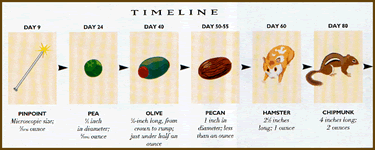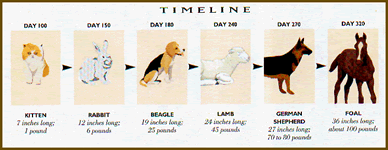Foal development timeline
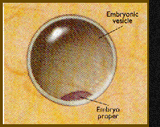 Day 9
Day 9
The "embryonic vesicle," which houses the embryo, is the only part of the egg visible at 9 days. The vesicle appears as a translucent bubble, less than a quarter inch in diameter. Upon an ultrasound screen, it will be visible as a black circle within a large grainy gray background (your mare's uterus). At this point, the embryo is smaller than a pinpoint.
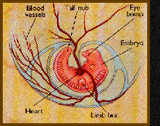 Day 24
Day 24
The vesicle will grow to 1 inch in diameter. It's a shimmering, flabby, translucent bubble with a dark red embryo at one end. A network of threadlike blood vessels grows out a quarter inch from the embryo. Beginnings of animal features (such as: a head with small eyes, a fleshy tail nub, and four smallish buds that will eventually grow into legs. On the ultrasound monitor, you will see the vesicle as an irregular, guitar-pick shaped black dot in a grainy gray backdrop. Generally, around Day 24 an embryonic heart is large enough to be seen on the ultrasound screen. To find it, focus on the bottom surface of the embryo. You will see a white smudge, about a half inch in diameter, resting there. Within that smudge, you will see a tiny black dot, about the size of a pinpoint, that will be flashing on and off like a computer's screen's cursor; this is the pea sized embryo's beating heart.
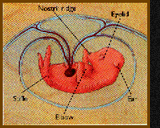 Day 40
Day 40
The
vesicle is now 2 ½ inches in diameter,
roughly spherical in shape, and somewhat collapsed.
The ¾ inch embryo within is now
recognizable as a four-legged critter: it has
a blobby dome for a head, eyelids, rudimentary
ears, ridges where the nostrils will be, and functional
elbows an stifle joints. An ultrasound would reveal
the vesicle as a roundish black blob: look the
white smudge of an embryo to be suspended from
the blob's ceiling, rather than resting on its
floor. This shift of position is step one in what
researchers call "the rise and fall of the
embryo." It results from filmy membranes
at the top of the vesicle coming together to form
the umbilical cord. As they do so, they shorten,
pulling the olive-sized embryo up to the ceiling
like a chandelier.
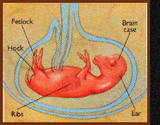 Day 50
Day 50
The embryo is now slightly over an inch long, nesting within the confines of the 3-inch vesicle. You can see tiny ribs under its skin; its domed head looks like that of a Chihuahua, and has developed a distinct skull. Little triangles represent its ears; the hock and fetlock joints have developed. At this stage, your future foal officially will graduate from embryo to fetus. On an ultrasound monitor, you'll find the fetus back on the vesicle's floor, due to a lengthening of the umbilical cord. Because of its size-now about that of a pecan; this will be your last opportunity to view the fetus via ultrasonography; in a matter of weeks, it'll be too large for the screen.
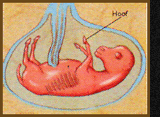 Day 60
Day 60
The vesicle is now flabby and shapeless, conforming to the uterine walls; the fetus is about 2 1/2 inches long. You can see that it clearly resembles a horse, thanks to the developemnt of tiny hooves, complete with soles and frogs. Its head is still tucked, but less so than before. The fetus is hairless, and about the size of a hamster.
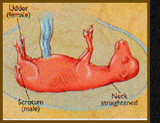 Day 80
Day 80
The fetal head and neck will be untucked, and are being held level with the spine in the "normal" horse position. Its sex is now visable: you can see that little lumps have formed for the scrotum, if it's a male, or the udder, if its a female. The fetus is now about the size of a chimpmunk.
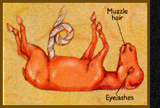 Day 150
Day 150
Gaining more than a pound every 10 days, the fetus now is about the size of a rabbit. Hair graces its chin, muzzle, and eyelids. If you look closely, you'll see that eyelashes have emerged.
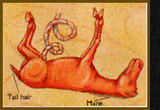 Day 180
Day 180
The fetus has quadrupled its weight in just 30 days. Mane and tail hairs have appeared; it's about the size of a Beagle.
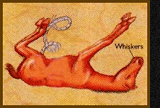 Day 240
Day 240
Now about the size of a small lamb, the fetus has whiskerlike hairs on its chin, throat and muzzle.
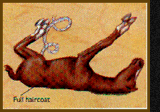 Day 270
Day 270
Your mare's fetus now looks like a foal: fine hair covers its body, and it now has a swatch of hair on its tail. It's about the size of a German Shepherd.
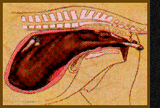 Day 320
Day 320
In the last week or so, the fetus's lungs have developed to the point that they can function in the "real world"; its legs have strengthened to the point that they can support it's weight; and it's hair has coarsened, from the fine, silky texture of fetus hair, to that of a bonafide foal. As far as development goes, the fetus is "done." You'll get the chance to meet your mares' foal in a matter of days or weeks. (Normal equine gestation can range from 320 to 365 days.)
